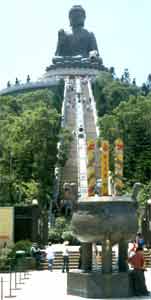China- Special Administrative Regions
| Hong Kong | Macau |
One Country, Two Systems. The special administrative regions of China are the former outposts of European colonial power that were returned to China in the latter part of the 20thcentury. This has created two capitalist enclaves for communist China but also different passport regulations, currency, and even flags.
 Hong Kong
Hong Kong
Hong Kong, the former British colony which Britain won from China during the Opium Wars in 1842 which allowed Britain to continue the opium trade from India to China. Eighteen years later Britain obtained the Kowloon peninsula and then in 1898 obtained a 99 year on the area that became known as the New Territories. The opium trade did not end until 1907. Japan invaded in 1941 but an influx of people from mainland China in 1949 attracted a lot of money to Hong Kong. Even at the height of the Cultural Revolution, Hong Kong was too important to the Chinese economy for Beijing to interfere, even today Hong Kong is the largest source of foreign investment for China.
|
Hong Kong is the transportation hub for southeast Asia, you will probably pass through here, or Bangkok, if you are travelling anywhere in southeast Asia so you might as well visit for a few days. If you are travelling on the Cathay Pacific All Asia Pass you will see Hong Kong airport plenty of times. With almost 7 million people crowded into 1100 square kilometres its one of the most densely populated areas of the world. Hong Kong Island is only about 165 square kilometres in area but it is the administrative and business centre of the region and is probably one of the world's most spectacular urban landscapes. I think Rio de Janeiro is the most spectacular. You probably will not be staying here, unless your a business traveller but you will probably visit, either to take the tram up Victoria Peak or a ferry to one of the outer islands. |
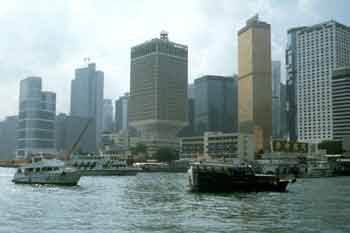 |
|
Victoria Peak is 550 metres high and provides excellent views of central Hong Kong and Victoria Harbour. Apparently because of land reclamation projects, Victoria Harbour is only half the size it use to be, maybe in the future there will be no need to use the Star Ferry. Although buses to go to the top of Victoria Peak, most people take the funicular railway known as the Peak Tram which takes 1400 metres and seven minutes to climb 373 vertical metres, its been operating since 1888. Kowloon is the four kilometre strip of land grabbed by the British in 1860 and is the tourist heart of Hong Kong. This area of Hong Kong seems to be
continuously building itself, anything considered old is torn down and replaced by something bigger. Nathan Road is the main
thoroughfare and is always packed with shoppers and hawkers. You can't walk 5 metres without someone trying to sell you a suit or a counterfeit watch. Unless you like shopping there is not much to see although the Hong Kong Cultural Centre is worth a visit, if for no other reason but to get away from the maddening crowds. There were few visitors when we were there, must have been too busy shopping. Hong Kong is the most customer driven place I have ever been. Don't get me wrong, I am the product of the North American customer society and I enjoy my collection of stuff as much as anyone but I found Hong Kong too much. There are also few bargains although the night markets can be enjoyable and the food is great.
The New Territories and outlying islands became part of Hong Kong in 1898. The New Territories comprise 750 square kilometres of Hong Kong and much of it is still rural although there are also the recent New Towns. The New Towns are responsible for most of the construction in Hong Kong in the past 20 years. They are basically collections of eight to ten towers of 50 to 60 story buildings which are constructed on a 3 or 4 story base. Up to 10,000 people can live in each tower and the base will contain schools, medical clinics, shopping and the other essentials of modern urban living. Each apartment averages about 50 square metres with up to four people in each apartment, often each having their own television. You will notice these New Towns on your trip to and from the airport. Most of the outlying islands can be visited, the ferry terminal is located on Hong Kong island. Most of the outlying islands are undeveloped and you can visit old fishing villages and experience relative rural calm. One island I would recommend visiting is Lantau, apparently over 50% of it is suppose to be a country park. The new airport is built on reclaimed land on the west side of the island and a new Disneyland is being developed on the north side of the island but if you arrive via ferry you will see neither and can experience rural Hong Kong. Its about an hour ferry ride from Hong Kong Island. |
|
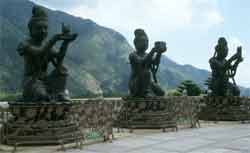
Most people visit Lantau Island, which is about twice the size of Hong Kong Island to visit the Po Lin Monastery and the Tian Tan Buddha. The monastery is about 45 minutes from the ferry terminal on a bus. If you can get off the ferry as quick as possible because sometimes there are more people than buses and its a long wait between buses. The bus ride gives you a nice unofficial tour of the island. The monastery is located on the Ngong Ping Plateau and was established in 1927, there is an excellent vegetarian restaurant. Everyone comes to see the Giant Buddha, at 26 metres and weighing 202 tonnes its the largest seated bronze outdoor Buddha in the world. You can sometimes see the Buddha as you land or take off from the airport.
Hong Kong has a reputation of being markedly less friendly and polite than other Asian cultures and even most Western cultures but my experience was that they were no worse, or better, than most large cities I have visited. Also the standard of English has
supposedly decreased since the 1997 handover from England since English instruction was scrapped but I never experienced much trouble. Having said that I found the city kind of cold and having visited once I don't plan to visit again except as a stopover. Unless you love shopping, the city is all about shopping.
 Macau
Macau
A recent addition to the World Heritage list, Macau is 60 kilometres west of Hong Kong on the other side of the Pearl River Delta, its an hour by high speed ferry. Even though you are still in China you have to get an exit stamp when you leave Hong Kong and pass through
immigration control when you arrive in Macau. Macau also has a different currency from Hong Kong and China, one country three currencies. The Macau pataca is worth slightly less than the Hong Kong dollar but most places in Macau will accept the HK dollar at face value, most day-trippers don't brother exchanging currency.
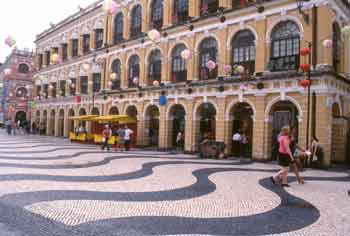
Macau was first established in 1557 by the Portuguese and for a brief period with trade links in Japan, India, and Indonesia Portugal were the sole agents of trade in east Asia but by the 17th century with defeats in the war with Spain and the rise of the Dutch as a trading power the importance of Macau decrease. The establishment of Hong Kong by the British sealed Macau fate to be a backwater. In 1974 with the end of the fascist dictatorship in Portugal, the Portuguese tried to give Macau back to the Chinese but were refused. Only after the agreement with the British about Hong Kong's fate was the Macau issue settled and with no fanfare Macau was returned to China in 1999. Like Hong Kong, Macau is a capitalist enclave in communist China. Unlike Hong Kong its main economic activity is not trade and manufacturing but gambling which has been legal since the 1850's.
Macau is both smaller in size - 24 square kilometres - and population - 500,000 - than Hong Kong so most of the sites can be visited in a day trip from Hong Kong. Consisting of a thin sliver of land on the mainland and two small islands, most of the main sites are on the mainland.
As soon as you are through immigration purchase a return ticket if you plan on returning to Hong Kong that evening, the late ferry can sell out quickly, especially on the weekend when many people from Hong Kong visit. The centre of the Macau peninsula is Largo do Senado (Senate Square) which was spruced up by the Portuguese government before the handover, this marks the downtown area and looks more like Southern Europe than East Asia. 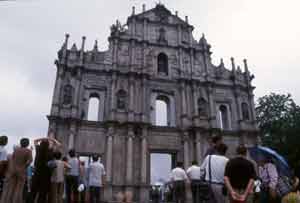 The entire area around Largo do Senado feels like Portugal. Also in the area is the 17thcentury Baroque church São Domingos and the Leal Senado which use to house the senate which is still used by the municipal government.
The entire area around Largo do Senado feels like Portugal. Also in the area is the 17thcentury Baroque church São Domingos and the Leal Senado which use to house the senate which is still used by the municipal government.
A few hundred metres north of Largo do Senado stands Macau's most famous landmark, the facade of the church of São Paulo which was once hailed as the greatest Christian monument in east Asia. The church was built at the beginning of the 17thcentury but was destroyed by fire in 1835, only the front facade remained. Immediately east of the church is the fort Fortaleza do Monte which houses the Macau Museum. You can see most of Macau from the fort ramparts - makes you think Hong Kong must have looked something like this 50 years ago.
There are a few other historic sites in Macau, in fact because there has been less construction in Macau more of the historic character of the city has been preserved than in Hong Kong. There are several land reclamation projects going on, soon the islands of Taipa and Coloane will be one. Like Hong Kong the main language is Cantonese but more people speak Portuguese as a second language than English. People in Macau are even less friendly than in Hong Kong but it is worth a day-trip.
| Return to Travel Page | Return to Main Page |
